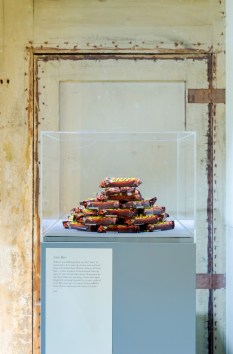
During the pandemic, museums supported the mental health of their communities in creative and generous ways. Some created outdoor art installations to boost the spirits of people in nursing homes and hospitals. Others provided online art therapy programs or used their collections and connections to offer mindfulness and meditation opportunities online, or via podcasts. The success of these programs may ensure they continue to be offered even as the pandemic fades. Long term, all museums can consider how they might explore mental health in a way connected with their mission. Today on the blog, Rachel Mackay, Manager of the History Royal Palaces properties within the Royal Botanic Gardens Kew, tells us how she and her colleagues rose to this challenge.
— Elizabeth Merritt, Vice President, Strategic Foresight and Founding Director, Center for the Future of Museums
2020 marked 200 years since the death of King George III, a King best known for two things: losing America, and being mentally ill. At Kew Palace, the royal residence with which George is best associated, we at independent charity Historic Royal Palaces (HRP) are well placed to tell a more rounded story. This year, we launched a new exhibition, George III: The Mind Behind the Myth, which used emotional historic and contemporary displays to challenge our attitudes towards mental ill health.
Kew Palace, located in the Royal Botanic Gardens Kew in west London, is the smallest royal palace in the UK. Kew played different roles in George’s life: schoolhouse, family home and sanctuary. At times it was a place of rest and recuperation; at other times it must have felt like a prison, as the King was held against his will and forced to undergo brutal treatment in an attempt to cure his mental and physical ill health.
With all this history in one place, Kew Palace was the perfect place to reconsider George, and in particular, tell the story of the remarkable mind that lay behind the myth of his much misunderstood ‘madness’. However, at HRP, we don’t aim just to tell compelling stories. In 2019, we adopted a new organisational cause: “to stir every spirit in order to inspire and provoke change”. With The Mind Behind the Myth, we wanted to change how people thought; not just about George, but about mental health today.
Even before we addressed this topic specifically, George’s health–how he felt about it, and the impact it had on his family—have always been themes that resonate heavily with our visitors. I’ve always been amazed at how relevant this story of a long dead monarch can seem to people today, and how some of the things he wrote at the time still ring true. “I have been ill 17 weeks,” he wrote, after his first bout of ill health. And then, obviously worried about the things he had said and done when he wasn’t fully in control, he continued “I must have lost some friends in that time.”
Knowing that this was a story that could be triggering to many, one of the most important starting points for the exhibition was putting an authentic contemporary lens onto George’s experience by ensuring we were including the voices and ideas of people who had been through something similar themselves. Our Communities and Interpretation teams worked with a variety of local community groups, building a team of contributors who helped us interpret the historic items on display by highlighting their own experiences.
For example, one of the objects was a letter from the King’s doctors to one of his daughters, Princess Mary. The doctor gives Princess Mary advice about how to look after her father after his illness. Alongside our curator’s historic object label, we have a label written by one of our community contributors, who talked about how the letter made him wonder about what advice doctors gave his own family when he was unwell. “Becoming unwell can be scary, for the individual and those around them, particularly if this is the first incident,” he writes. “Sometimes there is no right or wrong – just the need to approach people with care, good intentions and compassion.”
This interpretative approach is continued throughout the historic exhibition, which covers the first and second floors of the Palace. On the third floor, we displayed contemporary objects relating to mental health lent by members of the public. Beside each object, be it a carrier bag, a skateboard, a pile of Lion bars, we display the personal mental health story of each lender, told in their own words. The effect, especially when experienced against a specially created arrangement of Handel’s Saraband in D Minor (George’s favourite piece), can be extremely emotional.

In order to prepare our Visitor Host team for the exhibition, we worked with a variety of partners. For example, it was really important to me that during training, the Hosts got some time with the members of our community group, so that they could hear stories of lived experience for themselves and consequently, have richer and deeper interactions with visitors.
Another important element was understanding that we’re not the experts when it comes to mental health. Charity partnerships were particularly important. For example, we worked with suicide prevention charity Campaign Against Living Miserably (CALM) to provide signposting resources in the form of postcards and beer mats and to deliver bespoke training to our team, focusing on how to talk about mental health and suicide in a non-therapeutic setting. This meant that, although we were not encouraging our team to start counselling visitors, they were confident in having conversations and signposting or escalating where appropriate.
You can find out more about the model I developed to support our team with difficult content here.
I’m very proud of this year’s Host team at Kew. It isn’t easy to talk about mental ill health all day every day for four months, but it was clear just from overhearing conversations on site and looking at our visitor feedback that they were delivering profoundly changing experiences.
For many, it was clear that the exhibition had been the starting point for a deeper conversation, as one respondent commented:
“Incredibly brave exhibition from HRP. I’m a mother to teen boys, follow CALM on social media but the CALM beer mats worked a treat to start a conversation with my “tween” about male mental health. It was so apposite to have this at Kew. The pandemic has lifted the lid on mental health and hopefully exhibitions like this will keep the conversation going.”
Using contemporary objects to support a historic story was a new experience for us at HRP, but the feedback suggests it gave great value to the experience:
“Incredibly moved and connected. The third floor of the exhibition was amazing. The ten items donated by ones with mental illness was so inspiring. The courage to expose themselves in such a personal way had my husband and I shedding a few tears. We sat down afterwards to reflect on the cruelty shown to George, the love he had for his family and the various types of mental illness experienced in society now.”
For me, the transformative nature of this exhibition could not have been achieved without the planning and thought that went into the project. Telling authentic stories responsibly, and taking care of our contributors and team members meant we were able to touch people on a deeper level and hopefully change how they will think about mental health in the future.
George III: The Mind Behind the Myth ran at Kew Palace from June – September 2021. You can find some of the content, including videos from our contemporary lenders here.








